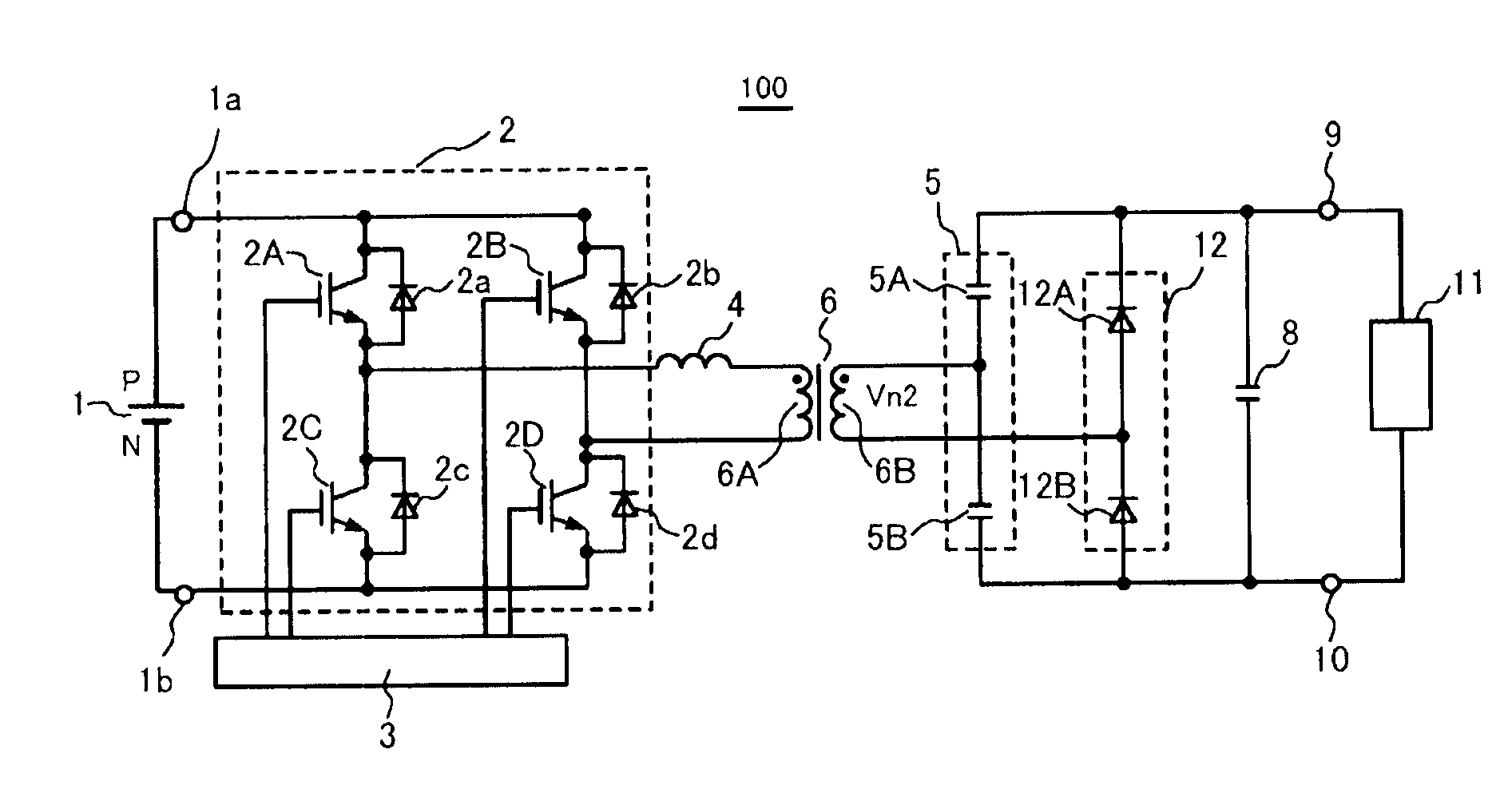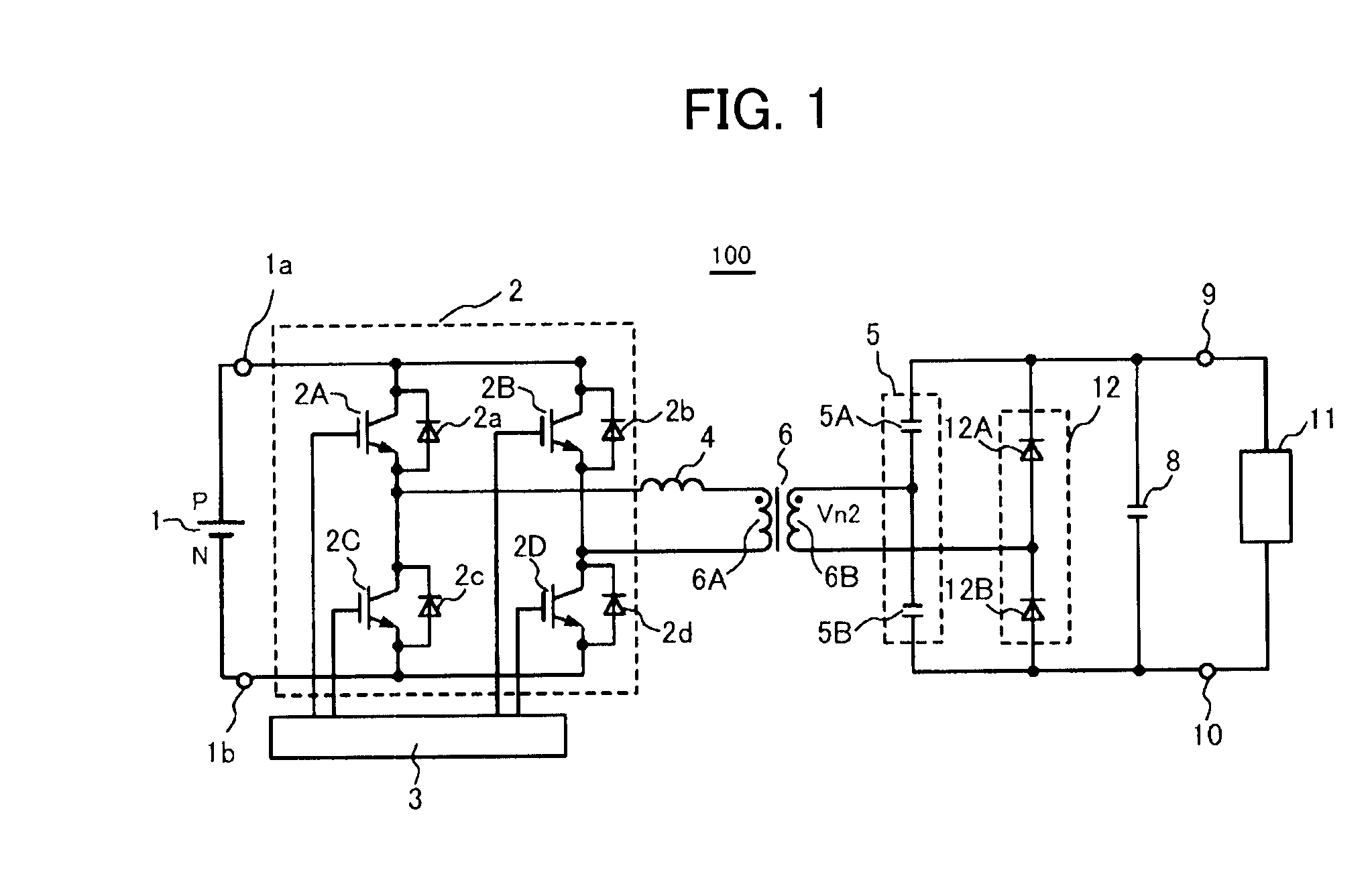Series resonant converter
a series resonant converter and series resonant technology, applied in the direction of electric variable regulation, process and machine control, instruments, etc., can solve the problems of unnecessary circuit loss power loss and noise generation, etc., to prevent the occurrence of recovery current and reduce power loss.
- Summary
- Abstract
- Description
- Claims
- Application Information
AI Technical Summary
Benefits of technology
Problems solved by technology
Method used
Image
Examples
first embodiment
[0027]A series resonant converter according to a first embodiment of the present invention is described with reference to FIGS. 1 to 4. FIG. 1 shows a circuit structure of a first series resonance type converter 100 of the present invention. The series resonant converter 100 includes a DC power supply 1, an inverter circuit 2, a control circuit 3, a resonant inductor 4, a resonant capacitor unit 5, a transformer 6 having a primary winding 6A and a secondary winding 6B, a unidirectional device unit 12, a smoothing capacitor 8, and output terminals 9 and 10. The primary winding 6A of the transformer 6 is connected to an inverter circuit 2 side via the resonant inductor 4, which is connected in series. One end of the secondary winding 6B of the transformer 6 is connected to the resonant capacitor unit 5 side and the other end of the secondary winding 6B is connected to the unidirectional device unit 12 side. A load 11 such as a common installation device including a vacuum device and a...
second embodiment
[0075]Next, a series resonant converter 200 according to the second embodiment of the present invention shown in FIG. 5 is described. A point of difference between the second series resonant converter 200 and the first series resonant converter 100 is that a reverse charge control diode 31 is connected in parallel with the first resonant capacitor 5A and a reverse charge control diode 32 is connected in parallel with the second resonant capacitor 5B.
[0076]Furthermore, the transformer 6 is a leakage transformer 6 including a leakage inductor 6C without the resonant inductor 4 shown in FIG. 1. That is, in the second embodiment, the leakage inductance 6C of the transformer 6 gives the overall inductance L of the resonant induction device necessary for series resonance. Since the leakage transformer 6 is a combination of the resonant inductor 4 and the transformer 6 in FIG. 1 in principle and is functionally the same as the first series resonant converter shown in FIG. 1, main operation...
third embodiment
[0084]Next, a series resonant converter 300 according to the third embodiment is described in FIG. 6. A normal half-bridge inverter circuit 2 is used in the series resonant converter 300. It is a half-bridge inverter circuit including a switching device arm connected in series with the two switching devices 2A and 2C, respectively.
[0085]In the half-bridge inverter circuit 2, a capacitor 2X is used instead of the switching device 2B and the feedback diodes 2b, and a capacitor 2Y is used instead of the switching device 2D and the feedback diode 2d of the full-bridge inverter circuit 2 in FIG. 1 or 5. Since an inverter circuit with fewer switching devices, as compared to the full-bridge inverter circuit, can be used, simplified control of the switching device can be made.
[0086]In the series resonant converter 300, a field-effect transistor (hereinafter referred to as FET) is used as the unidirectional device unit 12. The unidirectional device unit 12 is configured with a so-called sync...
PUM
 Login to View More
Login to View More Abstract
Description
Claims
Application Information
 Login to View More
Login to View More - R&D
- Intellectual Property
- Life Sciences
- Materials
- Tech Scout
- Unparalleled Data Quality
- Higher Quality Content
- 60% Fewer Hallucinations
Browse by: Latest US Patents, China's latest patents, Technical Efficacy Thesaurus, Application Domain, Technology Topic, Popular Technical Reports.
© 2025 PatSnap. All rights reserved.Legal|Privacy policy|Modern Slavery Act Transparency Statement|Sitemap|About US| Contact US: help@patsnap.com



